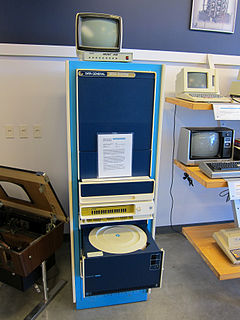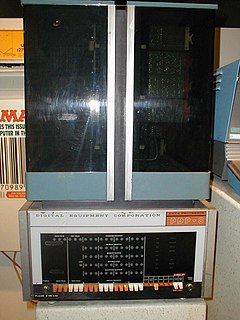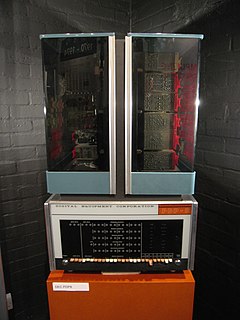A control store is the part of a CPU's control unit that stores the CPU's microprogram. It is usually accessed by a microsequencer. A control store implementation whose contents are unalterable is known as a Read Only Memory (ROM) or Read Only Storage (ROS); one whose contents are alterable is known as a Writable Control Store (WCS).

The Data General Nova is a series of 16-bit minicomputers released by the American company Data General. The Nova family was very popular in the 1970s and ultimately sold tens of thousands of units.
In processor design, microcode is a technique that interposes a layer of computer organization between the CPU hardware and the programmer-visible instruction set architecture of the computer. Microcode is a layer of hardware-level instructions that implement higher-level machine code instructions or internal state machine sequencing in many digital processing elements. Microcode is used in general-purpose central processing units, although in current desktop CPUs, it is only a fallback path for cases that the faster hardwired control unit cannot handle.

A minicomputer, or colloquially mini, is a class of smaller general purpose computers that developed in the mid-1960s and sold for much less than mainframe and mid-size computers from IBM and its direct competitors. In a 1970 survey, The New York Times suggested a consensus definition of a minicomputer as a machine costing less than US$25,000, with an input-output device such as a teleprinter and at least four thousand words of memory, that is capable of running programs in a higher level language, such as Fortran or BASIC.

Digital Equipment Corporation (DEC)'s PDP-10, later marketed as the DECsystem-10, is a mainframe computer family manufactured beginning in 1966 and discontinued in 1983. 1970s models and beyond were marketed under the DECsystem-10 name, especially as the TOPS-10 operating system became widely used.

The PDP-8 is a 12-bit minicomputer that was produced by Digital Equipment Corporation (DEC). It was the first commercially successful minicomputer, with over 50,000 units being sold over the model's lifetime. Its basic design follows the pioneering LINC but has a smaller instruction set, which is an expanded version of the PDP-5 instruction set. Similar machines from DEC are the PDP-12 which is a modernized version of the PDP-8 and LINC concepts, and the PDP-14 industrial controller system.

The Cray-1 was a supercomputer designed, manufactured and marketed by Cray Research. Announced in 1975, the first Cray-1 system was installed at Los Alamos National Laboratory in 1976. Eventually, over 100 Cray-1s were sold, making it one of the most successful supercomputers in history. It is perhaps best known for its unique shape, a relatively small C-shaped cabinet with a ring of benches around the outside covering the power supplies and the cooling system.
In computer architecture, 64-bit integers, memory addresses, or other data units are those that are 64-bit (8-octet) wide. Also, 64-bit central processing unit (CPU) and arithmetic logic unit (ALU) architectures are those that are based on processor registers, address buses, or data buses of that size. 64-bit microcomputers are computers in which 64-bit microprocessors are the norm. From the software perspective, 64-bit computing means the use of machine code with 64-bit virtual memory addresses. However, not all 64-bit instruction sets support full 64-bit virtual memory addresses; x86-64 and ARMv8, for example, support only 48 bits of virtual address, with the remaining 16 bits of the virtual address required to be all 0's or all 1's, and several 64-bit instruction sets support fewer than 64 bits of physical memory address.

Data General was one of the first minicomputer firms of the late 1960s. Three of the four founders were former employees of Digital Equipment Corporation (DEC).

The Z8000 is a 16-bit microprocessor introduced by Zilog in early 1979. The architecture was designed by Bernard Peuto while the logic and physical implementation was done by Masatoshi Shima, assisted by a small group of people. In contrast to most designs of the era, the Z8000 did not use microcode which allowed it to be implemented in only 17,500 transistors.
A processor register is a quickly accessible location available to a computer's processor. Registers usually consist of a small amount of fast storage, although some registers have specific hardware functions, and may be read-only or write-only. In computer architecture, registers are typically addressed by mechanisms other than main memory, but may in some cases be assigned a memory address e.g. DEC PDP-10, ICT 1900.

In computing, a memory address is a reference to a specific memory location used at various levels by software and hardware. Memory addresses are fixed-length sequences of digits conventionally displayed and manipulated as unsigned integers. Such numerical semantic bases itself upon features of CPU, as well upon use of the memory like an array endorsed by various programming languages.
Data General Business Basic was a BASIC interpreter marketed by Data General for their Nova minicomputer in the 1970s, and later ported to the Data General Eclipse MV and AViiON computers. Most business applications for the Nova were developed in Business Basic.
Addressing modes are an aspect of the instruction set architecture in most central processing unit (CPU) designs. The various addressing modes that are defined in a given instruction set architecture define how the machine language instructions in that architecture identify the operand(s) of each instruction. An addressing mode specifies how to calculate the effective memory address of an operand by using information held in registers and/or constants contained within a machine instruction or elsewhere.

DECtape, originally called Microtape, is a magnetic tape data storage medium used with many Digital Equipment Corporation computers, including the PDP-6, PDP-8, LINC-8, PDP-9, PDP-10, PDP-11, PDP-12, and the PDP-15. On DEC's 32-bit systems, VAX/VMS support for it was implemented but did not become an official part of the product lineup.
In computer engineering, an orthogonal instruction set is an instruction set architecture where all instruction types can use all addressing modes. It is "orthogonal" in the sense that the instruction type and the addressing mode vary independently. An orthogonal instruction set does not impose a limitation that requires a certain instruction to use a specific register so there is little overlapping of instruction functionality.
The Eclipse MV/8000 was the first in a family of 32-bit minicomputers produced by Data General during the 1980s. Codenamed Eagle during development, its architecture was a new 32-bit design backward compatible with the previous 16-bit Eclipse series. The development of the computer and the people who worked on it were the subject of Tracy Kidder's book The Soul of a New Machine. The MV/8000 was succeeded by the MV/6000, MV/8000-II, MV/2000, MV/2500, MV/4000, MV/10000, MV15000, MV/20000, MV/30000 and MV/40000. Later models such as the MV/40000 were SMP systems with hot-swappable components.
A stack register is a computer central processor register whose purpose is to keep track of a call stack. On an accumulator-based architecture machine, this may be a dedicated register such as SP on an Intel x86 machine. On a general register machine, it may be a register which is reserved by convention, such as on the PDP-11 or RISC machines. Some designs such as the Data General Eclipse had no dedicated register, but used a reserved hardware memory address for this function.
AOS/VS II is a discontinued operating system for the Data General 32-bit MV/Eclipse computers.
DG/L is a programming language developed by Data General Corp for the Nova, Eclipse, and Eclipse/MV families of minicomputers in the 1970s and early 1980s.










